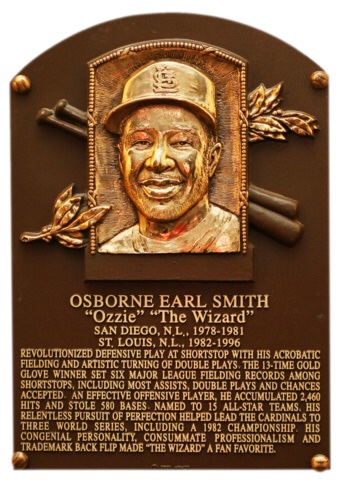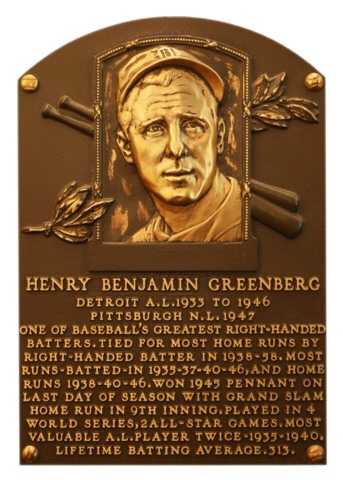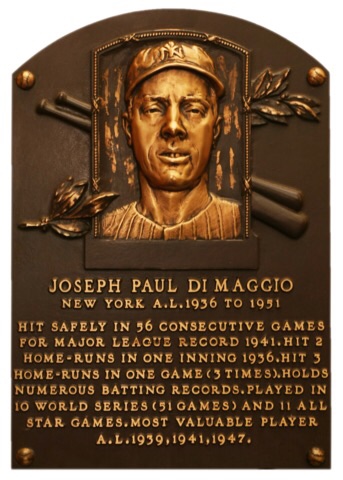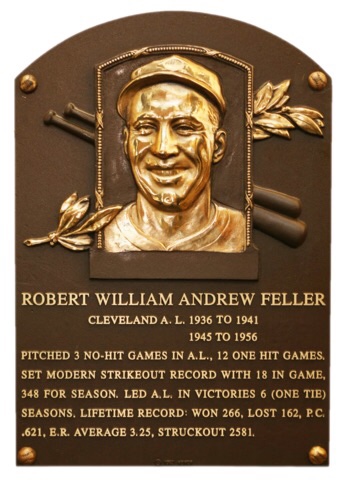[Editor’s Note: Paul is on his annual August break from site (although he’s still writing his weekly Bulletin column and may pop up here on the blog occasionally). Deputy editor Phil Hecken is in charge from now through the end of the month.]
Good morning Uni Watchers. I hope everyone is doing well and having a good week.
One of the things — despite living less than five hours away — I have never done in my life is to visit the Baseball Hall of Fame. It was actually a trip I had planned to take with my (then) wife, which we were going to combine with visits to our respective alma maters (both located in upstate NY). Alas, that trip never came to fruition, but I still hope to visit some day! From what I understand, to really see everything (and hopefully to see some stuff that’s “in the vault”), one needs to budget more than a full day.
Anyway, I tell you this because today we have a guest article from Louis Griffel, who will be taking us on a deep dive into several of the player plaques found inside Cooperstown’s hallowed halls. I think you guys will really enjoy this — I know it’s just made my HOF jones even stronger!
by Louis Griffel
If you are a baseball fan, visiting the Hall of Fame in Cooperstown, NY is probably on your bucket list. Living in the general NYC area, I have been fortunate that I have been able to visit Cooperstown many times, 18 times in total, since my first visit in 1984.
Having been to the Hall of Fame so many times, you start to notice things, and I have noticed a few that even the HOF employees who lead the tours don’t seem to know about. For example, you have likely seen at least pictures of several of the HOF plaques. They generally follow a standard format, which has evolved slightly over the years. Here is a picture of Sandy Koufax’s plaque as an example.

On Ozzie Smith’s plaque his nicknames are written in mixed case. His is the only plaque in the entire plaque gallery that contains any lower case letters at all. How did it happen? Who knows; but none before or since contain any lower case letters.

Interestingly, in almost all cases, they depict a photo of the player in the uniform of the team whose cap is shown on the plaque, but they list the name of the team that they historically consider to be the player’s primary team. There is an interesting fact that I noticed on Rollie Fingers plaque. He is appropriately depicted with an Oakland A’s logo on his cap, and Oakland is indeed denoted as his primary team. However, do you notice anything unusual about the cap on his plaque?
Let’s zoom in a little bit.
When choosing an image to use as the model for his plaque, it appears that even though there are innumerable images available of him as an A, an image from when Rollie was playing for the San Diego Padres was chosen. The artist changed the front logo, but either forgot to, or did not notice the bell panel lines from the Padres cap and left them. Also interestingly, his nickname, “Rollie” is not noted on the plaque.
Allowing players the deference to choose which team is depicted on their cap came to an end after Wade Boggs signed with Tampa Bay and allegedly allowed the inclusion of a clause that stated that if elected to the Hall of Fame his plaque would depict a Tampa Bay cap. Boggs has denied the story, but due to the reporting, and a few controversial choices in the previous decade (Reggie Jackson, Dave Winfield, Nolan Ryan) the Hall of Fame decided to take matters into their own hands and decided that while they would seek the input of inductees, the Hall would have final say over which cap would be depicted on the plaques.
This decision soon thereafter had an impact on the plaque of Gary Carter. Although Carter played the bulk of his career as a member of the Montreal Expos, and even had a final hurrah season with them in 1992, he wanted to have a Mets cap on his plaque, as he appeared in and won his only World Series with the Mets, and was an employee of the Mets at the time of his induction. With the Montreal Expos’ status in peril, though, the Hall seemed to want to have a player depicted as an Expo in the Hall and decided to depict Carter with an Expos logo on his cap. Now, in retrospect, if they had just been a little more patient, it would not have been an issue, as Andre Dawson and Tim Raines were both subsequently inducted as Expos.
Interestingly, Carter’s Hall of Fame page is one of the only ones (maybe the only, as I did not check every single HOFer’s page) that shows a picture of the player in a uniform different than the one depicted on their plaque.
Now, one thing about Carter’s case that always bothered me, was that there could have been an easy compromise as he could have been depicted wearing a backwards helmet, as he was frequently photographed as a catcher that way.
In fact, although they allowed no compromise for Carter, Greg Maddux, Mike Mussina, and Roy Halladay were all subsequently allowed to be depicted without a logo.
Several players from before this became a controversial issue are also depicted with no visible logo, including Yogi Berra and Catfish Hunter. The last point that I would like to touch on is the issue of missed time due to service in the armed forces and how that is or is not noted. Every Hall of Famer who served during a war has a medallion below their plaque that notes which war(s) they served in. This includes Morgan Bulkeley, who is the only member to serve during the Civil War.
As well as Ted Williams, who served in both WWII and the Korean War.
Now, as you can see, Ted Williams served during both WWII and the Korean War, missing nearly 5 full years of his career, yet his plaque merely notes that he played for the Boston Red Sox from 1939-1960.
Hank Greenberg missed nearly 4½ years, signing up to serve in WWII even though he didn’t have to, as he had just completed service in the reserves, yet here is his plaque.


The story is that Feller signed up to serve the day after the attack on Pearl Harbor, and that he was very proud of his service. Now, his actions are very commendable and he certainly provided a great service to our country. Is his service more commendable than that of Williams, Greenberg, and others? I am not going to debate that, but I will discuss the issues surrounding his plaque. Here is a picture of Bob Feller’s original plaque.
Here is a picture of his plaque circa 1991.
And here is a picture of his plaque that is hanging in the Hall of Fame today.

In an effort to find out, when I visited the Hall of Fame in 2017, I made an appointment to view Feller’s file in the Hall of Fame library. I was given two thick folders of news articles and photos to review. I spent a couple of hours going through everything with my son, but found absolutely nothing about the issue with his HOF plaque. At that point I approached the receptionist and told her that I was looking for information about why Bob Feller’s plaque had been changed twice, specifically around the war years issue. She told me that she didn’t know, but would call the library director and ask for me. Within 5 minutes the response that I received was that “it is a private matter between Mr. Feller and the Hall of Fame and that they would not comment further”.
While I completely support Mr. Feller and the Hall’s decision, from the point of view of a fan, transparency is always nice. I am sure that Feller’s teammate Bob Lemon is proud of his service, and I am sure the same of Enos Slaughter and Bill Dickey. Here are their plaques.
Most recently Gil Hodges was inducted on July 24th, and his plaque does show the gap for his military service.
While researching this piece I found the following blog post that discusses changed plaques in more detail, including more information about Feller, changes to Ted Williams’ plaque that I had not been aware of, as well as the changes to the plaques of Roberto Clemente and other Latin American Hall of Famers to more accurately depict their last names as they are traditionally done in their culture.
Many thanks to Phil for allowing me to write this piece, and to all of you for reading it. I hope you enjoyed it.

















Jackie Robinson’s link was link.
That should say, Jackie Robinson’s plaque was revised in 2008.
Yes, Jackie’s plaque revision and that of Roberto Clemente’s are well known and well publicized. My goal here was to focus on some less well known or explained plaque related details.
Uni-Watch get-together in Cooperstown? Equidistant between UW hq and sportslogos.net hq? Perfect excuse for Phil to go.
Great article. I have been to the HOF twice. I find the plaque gallery almost the least interesting part, not sure why, maybe because it’s the first thing you see or maybe because it’s hard to discern plaque to plaque who was really good or who is in for other (sometimes questionable) reasons. But the museum part is amazing and takes up the majority of your visit.
Great feature. I’ve always been of the opinion that if it isn’t overwhelmingly obvious what cap the player should be wearing, just go with a blank cap. It is the hall of FAME, so if the players fame is not tied directly to one team, leave it blank. Roy Halladay is a good example, he played the vast majority of his spectacular career with Toronto, but finished with a few years in Philly. Normally you’d say Toronto would be the obvious choice, but he had a perfect game and post season no-no in Philly, so how do split the difference?
The military service thing is interesting, specifically the multiple plaques for Feller. It would seem that since all who did serve feature a medallion under their plaque, why not just list the years of service in the military with that plaque. So for instance Feller’s plaque would have 1936-1956 on the plaque, and then 1941-1945 below the medallion.
I love your idea of how to note military service–seems to make a lot of sense to me.
Great piece today, really good read. Thanks.
Thanks so much!
I grew up about an hour from Cooperstown and have been to the Hall of Fame five or six times, including three times as a kid. A really, really special place.
And if your love of all things athletic aesthetic because you noticed as a kid whenever a baseball team was, say, wearing a different hat, then I highly recommend checking out Mickey’s Place, which has an amazing stock of baseball hats. I will happily give them my money whenever I can.
Louis – amazing article, well done!
Thank you!
Great insight into HOF plaques, really enjoyed it.
Normally I am not that much into HOF’s for any sport but this is the granddaddy of them all. Would like to visit it one day to see if my reluctance to visit a place like this has been totally misplaced or not. Great article by the way, with lots of interesting details, although I have never been a fan of the plaques: the faces depicted do not resemble the players at all in my opinion. I would prefer high quality photo prints on canvas framed in an player era-appropriate baseball card style with a front and a back with the stats on it hanging next to each other.
Thanks so much!
Funny, BHOF story. I went with my family while we were moving from Maine to Vegas driving across the country. That was my requested stop along the way, I took video (yikes sd from a camcorder), walked around Cooperstown. They have this field (Doubleday Field) where they play an old timey baseball game in old unis. Were watching the game and there is this chick behind me flashing her bare underparts at me the whole game, now were both in our early high school years (were talking like 1995 maybe). I spent from the third inning on trying to figure out how I was going to ditch my family for an hour to kick it with this chick. To no avail, but every time The Hall is mentioned I remember that day vividly.
jesus
I agree that the HOF feature was a great one. UniWatch is at its best when Paul, Phil, or a guest author take a deep dive into an area that most fans would have never thought about or made note of.
I visited Cooperstown many years ago. I’m due for a revisit soon. Great article!
Just a heads up, the link to Paul’s bulletin article doesn’t seem to be working, at least not for me
Makes no sense to not depict the break in years for military service. Makes you appreciate their playing accomplishments even more, knowing they’d be even better if they didn’t miss those years. Also strange that Yogi Berra’s plaque shows his profile, so no “NY”.
The one thing I’ve always fond interesting about HOF plaques is how they handle managers.
Bob Lemon (plaque pictured above) doesn’t mention his years as a manager at all. Neither does Lou Boudreau’s.
Tommy Lasorda, Sparky Anderson, Bobby Cox, Tony La Russa: no mention of their (undistinguished) playing time at all.
Joe Torre’s plaque refers to his years as a manager (starting with the Mets in 1977) and not his years as a player – but the text refers to his 18 years as a player, nine time all star, and MVP.
I didn’t dig too deep into older players, but John McGraw’s plaque (which doesn’t have years) mentions in the text both his time as a player and a manager.
The obvious answer is that some guys are in “as a player”, some guys are in “as a manager”. Lemon and Boudreau are obviously in as a player, the other four guys as managers.
Torre is the odd case because he had a near-HOF playing career and I guess his managing success put him over the top? But why mention his playing stats in the text and not in the years?
Also – presumably La Russa will get a new plaque when he finally retires, because the managing years on his plaque are now out of date.
Another interesting fact is that the header picture that Phil chose to go with the article is from about 10 years ago or so (maybe even slightly longer) before the Hall did their last major reorganization of the plaque gallery. Honus Wagner is now at the far end of the gallery with the “first five” plaques. This photo is also before the war insignias we’re added beneath the plaques, as you can see there is nothing below Morgan Bulkeley’s plaque on the far right.
Fantastic stuff today, Louis! I thoroughly enjoyed this dive into the world of Baseball Hall of Fame plaques. I always eagerly await the plaques’ unveiling every year, so this article was right up my alley. Thanks for sharing it!
Great article on the HOF